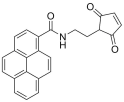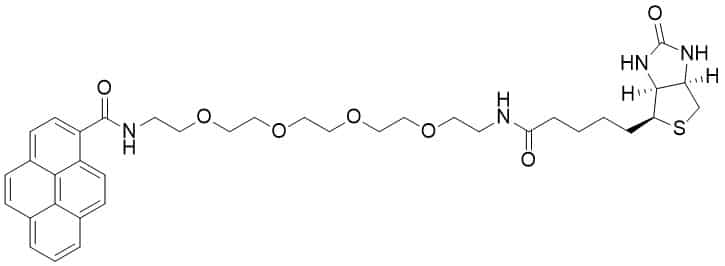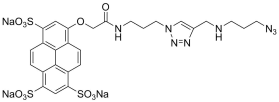Pyrene Probes
Pyrene in Bioconjugation: Features, Applications, and Quenching Experiments
Pyrene is a polycyclic aromatic hydrocarbon with a distinct four-ring structure, widely used in bioconjugation for labeling biomolecules due to its strong blue fluorescence and unique quenching properties. Its hydrophobic nature and high quantum yield make it an ideal tool for studying molecular interactions, especially in environments of varying polarity.
Key Features of Pyrene in Bioconjugation:
- Pyrene Structure: Pyrene has a planar, aromatic structure with four fused benzene rings, which contributes to its strong fluorescence and ability to participate in non-covalent interactions.
- Fluorescence Quenching and Polarity Sensitivity: Pyrene’s fluorescence is highly sensitive to its environment, particularly polarity. Quenching experiments with pyrene can reveal information about the local environment around the dye, such as changes in polarity or the presence of quenchers like oxygen or other molecules.
- Excimer Formation: Pyrene can form excimers (excited state dimers) when two pyrene molecules are close, resulting in a red-shifted emission. This property is used to study the proximity of labeled biomolecules.
- High Photostability: Pyrene resists photobleaching, making it ideal for long-term imaging and detection.
Applications of Pyrene in Bioconjugation:
- Fluorescent Probes: Pyrene-labeled probes are used to study molecular interactions, protein folding, and structural changes in biomolecules.
- Quenching Experiments: Pyrene quenching experiments help investigate molecular environments, detect polarity changes, and study binding interactions. Quenching by specific quenchers, like nitroxides, or changes in solvent polarity, can provide insights into the local chemical environment.
- Membrane Studies: Pyrene’s hydrophobic structure makes it useful for examining membrane fluidity, protein-lipid interactions, and microdomain organization.
- Biochemical Assays: Pyrene conjugates detect proteins, nucleic acids, and other biomolecules with high sensitivity, leveraging excimer formation for dynamic interaction studies.
Pyrene’s distinct structure, polarity-sensitive fluorescence, and quenching capabilities make it a powerful tool in bioconjugation, allowing researchers to explore complex biological environments and interactions with high precision and sensitivity.






![N-Bicyclo[2.2.1]hept-5-en-2-ylmethyl-4-pyren-1-yl-butanamide](https://e1752fbe.rocketcdn.me/wp-content/uploads/AP10619-CAS-2740616-64-0-1-e1687867798510.png)
![N-(2-(bicyclo[2.2.1]hept-5-ene-2-carboxamido)ethyl)pyrene-1-carboxamide](https://e1752fbe.rocketcdn.me/wp-content/uploads/AP10659-e1687868143872.png)










